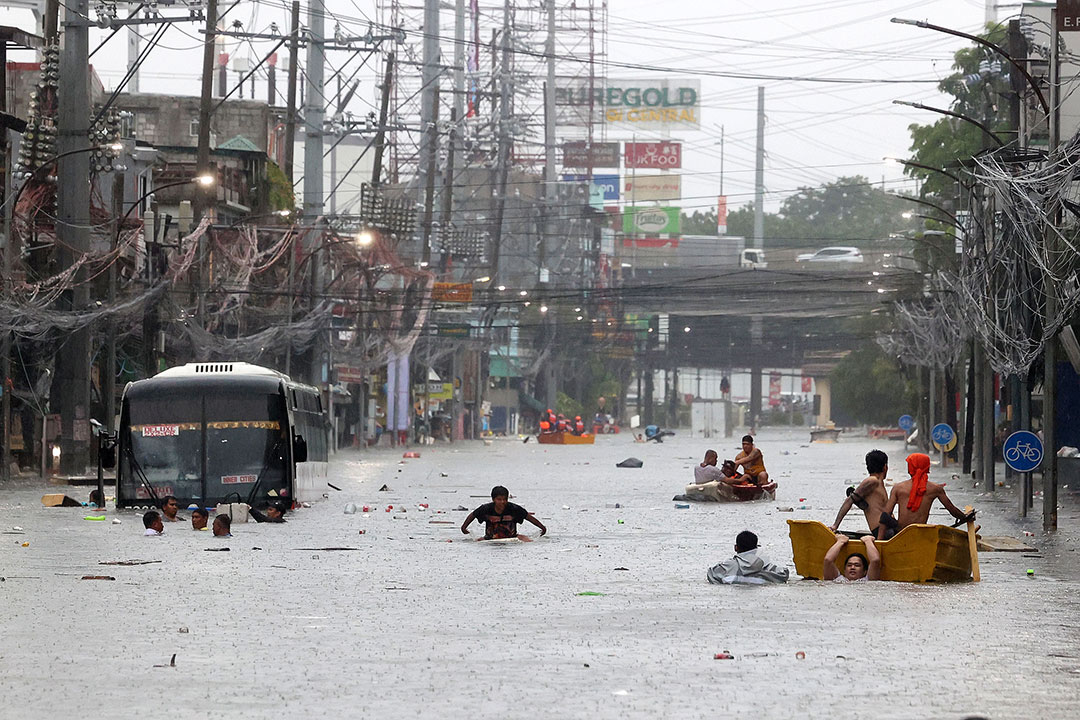
Static
By Marvin Tort

Typhoon Carina and the monsoon rains resulted in flooding in many parts of the country last week, which led to much damage not only in Metro Manila but more so in Northern and Central Luzon. Seeing how the floods adversely affected particularly land transport, I can only wonder if the recent typhoon is making electric vehicles (EV) owners rethink their purchases.
Late last year, I wrote about how improvements in EV range, and EV’s seemingly lower maintenance cost compared to regular cars, were making me consider shifting to an EV for daily use. But with last week’s rains, and the ensuing damage to many vehicles caused by the widespread flooding, I now have my doubts.
Car manufacturers, car dealers, and the motor vehicle insurance industry will be helping the market make a more informed decision on future vehicle purchases if they can make public any data on how vulnerable EVs and hybrid cars are to flood damage. Are EVs and hybrid cars more vulnerable than gas or diesel cars to severe or even “total” damage from floods?
Also, are flood-damaged EVs and hybrid cars more expensive or more difficult to repair? How big is the inventory of parts and components that manufacturers make available to car dealers to repair these EVs and hybrid cars? And, what is the level of expertise of dealerships to repair damaged vehicles in a timely manner? I reckon at this point EVs and hybrid cars can be repaired only by the casa or the dealerships.
I am unsure as to what metrics can be presented to the public. Perhaps the number of insurance claims filed by EV owners claiming flood damage? And of these claims, how many of these EVs or hybrid cars were declared a “total loss”? And maybe the average cost of repair for these EVs and hybrid cars? As for regular cars claiming flood damage, what percentage are declared a “total loss” and the average cost of repair?
I can only assume that flood damage to hybrid and EVs can present significant challenges for both owners and insurers. I am unsure how complex the process is of handling such insurance claims, but I guess even the level of expertise of in-house claims evaluators may not be very high when it comes to EVs and hybrid cars and determining whether they can be repaired.
It is my understanding that EVs and hybrids can incur higher repair costs due to their specialized components, particularly the battery, which I reckon can be highly susceptible to water damage as it is “electric” and is usually mounted at the bottom of the vehicle. The high cost of EV battery replacement may be enough to prompt insurers to classify flood-damaged EVs as total losses.
And given the relatively small size of the EV and hybrid market at present, there may be a limitation if not scarcity of parts and perhaps even the specialized skills required for repairs. And then there are the potential difficulties in processing claims. I am uncertain at this point if EVs and hybrid vehicles pay higher insurance premiums because of these reasons.
There have been enough public discussions on how damaged EV batteries can pose very serious safety risks, such as short circuits or fires, making EVs risky to repair in many cases. The standards required for containment, for instance, are also different for EVs compared to regular vehicles. Isolation and fire proofing are a must for damaged EVs under repair. In this sense, insurers may be more inclined to just pay for a total loss than pay for a costly and risky repair job.
The bigger question is how feasible it is to repair a flood-damaged EV. Also, is it cost-effective? Water exposure can already lead to extensive damage to the battery, electrical systems, and other critical components of regular cars, what more for EVs and hybrid vehicles? And, assuming cost-effective repairs are possible, what is the impact of flood damage on the long-term reliability of an electric vehicle?
For many flood-damaged regular cars, corrosion and electrical issues can persist after repairs, leading to recurring maintenance problems. And considering that EVs and hybrid vehicles may be more vulnerable to flood damage given the nature and character of their electrical systems, the risks posed by corrosion and electrical issues to them may be more severe.
Carina is one instance where transparency in insurance claims data will be helpful to the market. Car manufacturers and their dealers should also be upfront and forthright when responding to inquiries from customers on how their EVs and hybrid vehicles performed during and after the floods, and how their service centers dealt with flood-damaged vehicles.
The simplified approach is to simply declare as a total loss any EV that was submerged in flood water from maybe the dashboard and up, and for a specific period, say two hours or more. This can simplify the claims process, and, in a way, reduce future risks related to the performance and safety of an EV or hybrid car that is repaired. However, this can also be very costly to insurance companies, and the insured.
The issue is whether we can risk attempting extensive repairs on complex and sensitive machinery such as EVs and hybrid vehicles. It is a fact that EVs and hybrids do not run or operate anything like gas or diesel vehicles. In the coming months, I am sure the pre-owned market will be flooded — no pun intended — with relatively new cars.
Ultimately, the market might see a rise in insurance premiums for EVs and hybrid vehicles. At this point, I believe it will be difficult for the public to insist on parity with insurance premiums for regular cars. Again, claim history after Carina will be a determinant here, and perhaps the Insurance Commission should thoroughly analyze the data before making any calibrations.
Marvin Tort is a former managing editor of BusinessWorld, and a former chairman of the Philippine Press Council